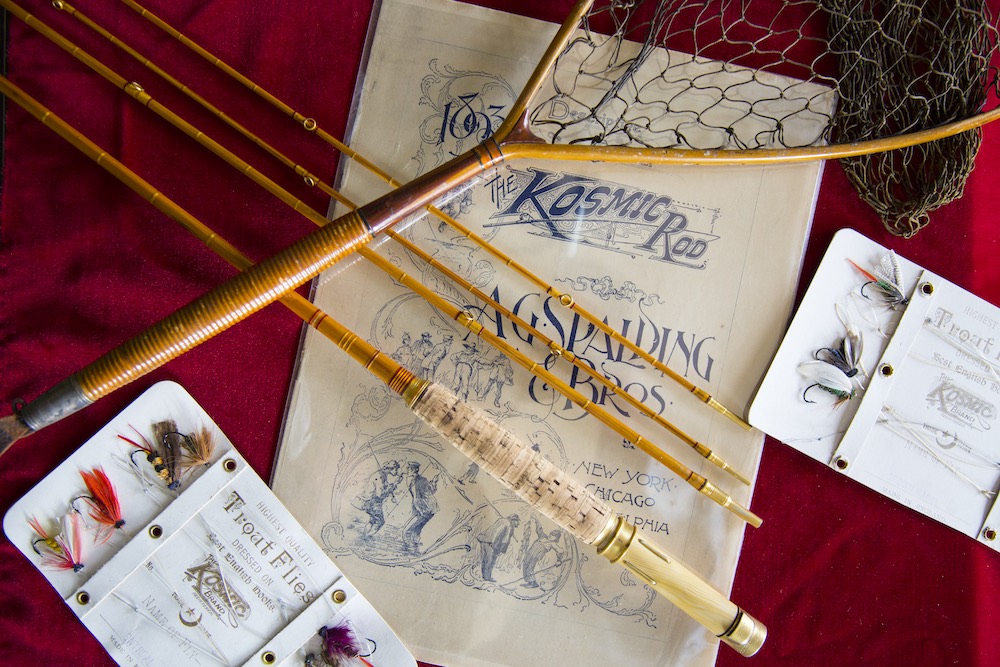
The Kosmic series of fly rods was created by the famous rod makers Fred Thomas, Eustis Edwards, and Loman Hawes, and later Ed Payne, who left the iconic rod maker Hiram Leonard to found their own company. The trio was backed by Albert Goodwill Spalding, the famed baseball pitcher for the Chicago White Stockings, who opened his own sporting goods outlet in Chicago, the A.G. Spaulding Brothers in 1876.
This rare Golden Kosmic bamboo fly rod, complete with gold fittings, was specially made for the 1893 World’s Columbian Exposition, an event that covered over 600 acres in Chicago, where the Kosmic line won the Award of Highest Merit. The Kosmic rods were a big hit at the time, marketed in part through the Spalding company catalog pictured here, along with a selection of early Kosmic trout flies on cards, which were dressed on English hooks and made in England.
Steve Woit is the author of “Fly Fishing Treasures: The World of Fly Fishers and Collecting”, a book featuring profiles of 30 experts and collectors and over 800 photographs of rare and collectible fly rods, reels, flies, books, and ephemera.






A very modern-looking fly rod.
It took a number of years for the great makers of my own country, Britain, to realise that Leonard and the Americans were years ahead of them and own their rather clunky, heavy, over-thick creations. G.E.M. Skues, the father of British chalksteam nymph-fishing (I knew and fished with a man, Bertram Hoare, born in 1900 – 02, who was an already very fine young flyfisher in 1914 or ’15 when showed Skues around his parents’ stretch of little chalk river in Hampshire and showed him where the best trout lived), tried to tell them, the British makers, that the Americans were way ahead when it came to cane fly rods, when he wrote about his “W.B.R.” – the world’s best rod – a Hiram Leonard, a few years after his day or two on a river near Basingstoke (which was Strictly Dry Fly Only, back then, by the way – as was Bertram many many years on when I knew him when he was in his late seventies and early eighties, when he had still had 20-20 on-river small fly vision and was an incredible flyfisher).
Anyway, something about Skues and his Leonard WBR below. “Son of Kosmic”, so to speak.
http://www.tomsutcliffe.co.za/rss-feed/item/841-what-fly-rod-did-gem-skues-rate-as-his-best-and-why
PS – Correction: – “FATHER of Kosmic”
Third thought about sticks both ancient and modern.
The WBR was a bit of a slow-actioned “buggy whip” – as were most rods back then and for many years afterwards here in Britain. To like a fast-actioned (or, dismissively, “tip-actioned” “tut tut…”) fly rod was to be nothing less than a colonial rebel / terribly affected American – even well into the 1970s here in Britain. Old, strictly upstream dry fly only, Bertram mentioned above, was some distance ahead of the rest of his and several later blinkered generations though: he fished an up-to-the-minute, ultra-light 8ft (“terribly short … harrumph…”, in the old donkeys’ eyes) fast-actioned, American glass Fenwick rod when I met him, and was fascinated by my fast-actioned, bought for a very few pounds from him, early Tom Moran, cane 8-foot 4/5-weight and the just appearing from the States (Lamiglas and the like) very early graphite rods, some of the latter being “a bit too sharp, even for my [cover a riser quickly with the minimum of false casting] taste, Paul…” (according to the still some way ahead Bertram).
Sticks, huh?
i need a paper catalog on your rods i want to buy some
i want a paper catalog i want to buy some rods.